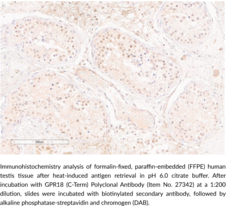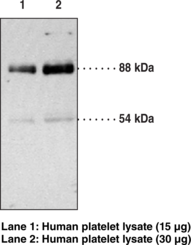Description
GPR18 is a G protein-coupled receptor (GPCR) that is expressed in lymphoid tissues, lung, brain, testis, and ovaries.{48187} It is coupled to the Gαi/o and Gαq/11 transduction pathways and is activated by the polyunsaturated fatty acid metabolite resolvin D2 (Item No. 10007279) and the endocannabinoid arachidonoyl glycine (NAGly; Item No. 90051). Resolvin D2-induced activation of GPR18 reduces inflammatory pain induced by formalin, carrageenan, and complete Freund’s adjuvant (CFA) in rats and reduces production of pro-inflammatory cytokines in mouse models of cecal ligation and puncture-induced sepsis, ocular infections, and ischemic injury.{42687,48188} NAGly-induced activation of GPR18 lowers intraocular pressure (IOP) in mice in a fatty acid amide hydrolase-dependent manner.{48189} GPR18 is also overexpressed and constitutively active in patient-derived metastatic melanoma tumor samples.{48190} Cayman’s GPR18 (C-Term) Polyclonal Antibody can be used for ELISA and immunohistochemistry (IHC) applications. The antibody recognizes the C-terminal region of GPR18 from human samples.
Synonyms: G Protein-Coupled Receptor 18|GPCRW|NAGly Receptor|N-Arachidonyl Glycine Receptor
Immunogen: Synthetic peptide from the C-terminal region of human GPR18
Formulation: 500 µl of Peptide affinity-purified antibody
Isotype:
Applications: ELISA and IHC
Origin:
Stability: 365 days
Application|ELISA||Application|Immunohistochemistry||Product Type|Antibodies|Polyclonal Antibodies||Research Area|Immunology & Inflammation|Inflammatory Lipid Mediators|Specialized Pro-Resolving Mediators||Research Area|Immunology & Inflammation|Innate Immunity|Sepsis/Shock||Research Area|Lipid Biochemistry|Fatty Acids|Degradation||Research Area|Neuroscience|Ophthalmology



